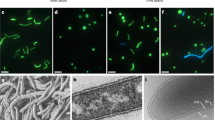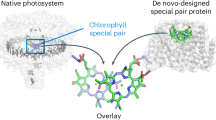Abstract
PREVIOUS work has established reasonably well that the reorientation or removal of water molecules bound to macromolecules may result in the loss of viability and infectivity of bacterial cells and virus particles1. During the above studies when auxotrophic cells were held at certain levels of relative humidity (RH), prototrophic mutants were found, apparently produced as a direct result of desiccation. Later the mutation of bacterial cells by ultra-violet light was found to be more easily achieved if the cells were partially desiccated at 40 per cent RH (ref. 2), indicating that bound water molecules played some part in the mechanisms responsible for mutation. Cells or virus particles held at RH levels between 80 and 30 per cent contain from 35 g water/100 g of cell solids (35 per cent water) to 3 per cent water1. Because 30–40 g water/100 g of solid is just sufficient to hydrate fully protein RNA and DNA, desiccation below 80 per cent RH affects only the quantity of bound water in the cell. The apparent mutation of cells from desiccation suggested that water molecules were, in part, responsible for maintaining the biological integrity of DNA, and therefore further studies were warranted. It is the purpose of this paper to present the results of preliminary investigations.
This is a preview of subscription content, access via your institution
Access options
Subscribe to this journal
Receive 51 print issues and online access
$199.00 per year
only $3.90 per issue
Buy this article
- Purchase on Springer Link
- Instant access to full article PDF
Prices may be subject to local taxes which are calculated during checkout
Similar content being viewed by others
References
Webb, S. J., Bound Water in Biological Integrity (Chas. C. Thomas, Illinois, 1965).
Webb, S. J., Nature, 203, 374 (1964).
Langstroth, G. O., Diehl, C. H. H., and Winhold, J., Canad. J. Res., 28, 580 (1950).
Davis, B. D., and Mingioli, E. S., J. Bact., 60, 17 (1950).
Falk, M., Hartman, K. A., and Lord, R. C., J. Amer. Chem. Soc., 85, 387 (1963).
Webb, S. J., and Dumasia, M. D., Canad. J. Microbiol. (in the press).
Author information
Authors and Affiliations
Rights and permissions
About this article
Cite this article
WEBB, S. Mutation of Bacterial Cells by Controlled Desiccation. Nature 213, 1137–1139 (1967). https://doi.org/10.1038/2131137b0
Published:
Issue Date:
DOI: https://doi.org/10.1038/2131137b0
This article is cited by
-
Preservation of immobilized bacterial cell-matrix by drying for direct use in microbial sensors
World Journal of Microbiology and Biotechnology (1993)
-
DNA-strand breaks limit survival in extreme dryness
Origins of life and evolution of the biosphere (1991)
-
Limits to life at low temperatures and at reduced water contents and water activities
Origins of Life (1980)
-
Effect of Dehydration on Bacterial Recombination
Nature (1968)
-
Mutability of Stored Spores of Bacillus subtilis
Nature (1968)
Comments
By submitting a comment you agree to abide by our Terms and Community Guidelines. If you find something abusive or that does not comply with our terms or guidelines please flag it as inappropriate.



